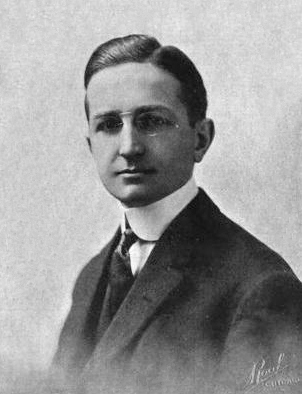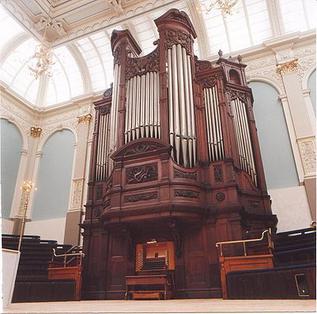
The clavichord is a stringed rectangular keyboard instrument that was used largely in the Late Middle Ages, through the Renaissance, Baroque and Classical eras. Historically, it was mostly used as a practice instrument and as an aid to composition, not being loud enough for larger performances. The clavichord produces sound by striking brass or iron strings with small metal blades called tangents. Vibrations are transmitted through the bridge(s) to the soundboard.

Charles-Marie-Jean-Albert Widor was a French organist, composer and teacher of the late Romantic era. As a composer he is known for his ten organ symphonies, especially the toccata of his fifth organ symphony, which is frequently played as recessional music at weddings and other celebrations.

The pipe organ is a musical instrument that produces sound by driving pressurised air through the organ pipes selected from a keyboard. Because each pipe produces a single pitch, the pipes are provided in sets called ranks, each of which has a common timbre, volume, and construction throughout the keyboard compass. Most organs have many ranks of pipes of differing pitch, timbre, and volume that the player can employ singly or in combination through the use of controls called stops.

In music, the organ is a keyboard instrument of one or more pipe divisions or other means for producing tones. The organs have usually two or three, up to five, manuals for playing with the hands and a pedalboard for playing with the feet. With the use of registers, several groups of pipes can be connected to one manual.

The Toccata and Fugue in D minor, BWV 565, is a composition for organ by, according to the oldest sources, German composer Johann Sebastian Bach and is one of the most widely recognisable works in the organ repertoire. Although the date of its origin is unknown, scholars have suggested between 1704 and the 1740s. The piece opens with a toccata section followed by a fugue that ends in a coda, and is largely typical of the north German organ school of the Baroque era.

A pedalboard is a keyboard played with the feet that is usually used to produce the low-pitched bass line of a piece of music. A pedalboard has long, narrow lever-style keys laid out in the same semitone scalar pattern as a manual keyboard, with longer keys for C, D, E, F, G, A, and B, and shorter, raised keys for C♯, D♯, F♯, G♯ and A♯. Training in pedal technique is part of standard organ pedagogy in church music and art music.

Ernest Martin Skinner was an American pipe organ builder. His electro-pneumatic switching systems advanced organ-building technology in the first part of the 20th century.
The Holtkamp Organ Company of Cleveland, Ohio is America's oldest continuously operating pipe organ workshop. The company was founded in 1855 by Gottlieb Votteler. The work produced by the shop has evolved over the years in terms of architectural style, sound, and mechanism. During this time, the company has had a number of names, including: The Votteler Organ Company, The Votteler-Hettche Organ Company, The Votteler-Holtkamp-Sparling Organ Company, and finally in 1951, The Holtkamp Organ Company.
The organ repertoire is considered to be the largest and oldest repertory of all musical instruments. Because of the organ's prominence in worship in Western Europe from the Middle Ages on, a significant portion of organ repertoire is sacred in nature. The organ's suitability for improvisation by a single performer is well adapted to this liturgical role and has allowed many blind organists to achieve fame; it also accounts for the relatively late emergence of written compositions for the instrument in the Renaissance. Although instruments are still disallowed in most Eastern churches, organs have found their way into a few synagogues as well as secular venues where organ recitals take place.
George Donald Harrison was responsible for the design of some of the finest and largest pipe organs in the United States. Born in Huddersfield, England, he first worked as a patent attorney in 1914 but after military service he began to pursue an interest in pipe organ building, working with Henry Willis & Sons of London.

Henry Willis & Sons is a British firm of pipe organ builders founded in 1845. Although most of their installations have been in the UK, examples can be found in other countries.

The organ of the St. Jacobi Church in Hamburg, was built from 1689 to 1693 by the most renowned organ builder of his time, Arp Schnitger. The organ boasts four manuals and pedal with 60 stops, 15 of which are reeds – and has approximately 4000 sounding pipes. All in all, from the organ's original installation and its condition today not much of its conception has changed. The old pipework and the prospect pipes have been preserved in almost original format. It is the largest organ in existence from before 1700 and is one of the most eminent Baroque instruments that have been preserved.

Pasi Organ Builders, based in Roy, WA, manufactures mechanical action organs and restores historic instruments. Martin Pasi received his first formal experience in organ building during a four-year apprenticeship with the Rieger Company in his native Austria. After working in Austria and in the United States, Pasi set up his own studio, Pasi Organ Builders, in 1990 in a former school building in Roy, Wash.

Montgomery Rufus Karl Siegfried Straube was a German church musician, organist, and choral conductor, famous above all for championing the abundant organ music of Max Reger.
Marcussen & Søn, also known as Marcussen and previously as Marcussen & Reuter, is a Danish firm of pipe organ builders. They were one of the first firms to go back to classical organ-building techniques, and have been producing mechanical-action organs since 1930. Aside from their many instruments in Denmark, they have built organs in northern Germany, Sweden, Finland, the Netherlands, Great Britain, South Africa, Japan, and the United States.
Richards, Fowkes & Co. is an American organ-builder. They make historical-style mechanical-action pipe organs. The firm is located in rural Ooltewah, Tennessee, just outside Chattanooga and was founded in 1988 by Bruce Fowkes and Ralph Richards.

An organist is a musician who plays any type of organ. An organist may play solo organ works, play with an ensemble or orchestra, or accompany one or more singers or instrumental soloists. In addition, an organist may accompany congregational hymn-singing and play liturgical music.
Johann Sebastian Bach's music has been performed by musicians of his own time, and in the second half of the eighteenth century by his sons and students, and by the next generations of musicians and composers such as the young Beethoven. Felix Mendelssohn renewed the attention for Bach's music by his performances in the 19th century. In the 20th century Bach's music was performed and recorded by artists specializing in the music of the composer, such as Albert Schweitzer, Helmut Walcha and Karl Richter. With the advent of the historically informed performance practice Bach's music was prominently featured by artists such as Nikolaus Harnoncourt, Gustav Leonhardt and Sigiswald Kuijken.

Charles Brenton Fisk was an American pipe organ builder who was one of the first to reintroduce mechanical tracker actions in modern organ building over electro-pneumatic actions.














